How to Integrate AI into Your Business Process
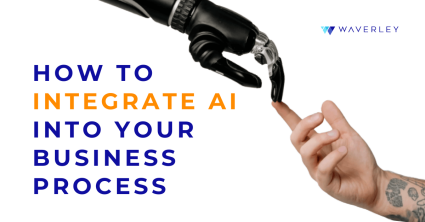
Contents
The effects of AI are felt everywhere, from the automation of manual work to the radical changes in customer relations and decision-making procedures. Artificial intelligence integration is no longer just a trend; it is now a strategic need as companies rapidly realize the potential of technology to increase productivity, reduce costs, and gain a competitive edge. The complex function of AI in contemporary business will be examined in this essay, along with its many applications, difficulties, and enormous opportunities for those who are ready to harness its potential.
Understanding AI Adoption Trends
Many factors, such as improvements in machine learning, more computer capacity, and a growing understanding of AI’s potential advantages, are driving the use of AI technology. Let’s review the most recent trends and data on the adoption of AI across industries and talk about the long-term potential and significance of AI in reshaping the business world of the future, as analyzed by a trusted machine learning development company.
AI Integration Trends
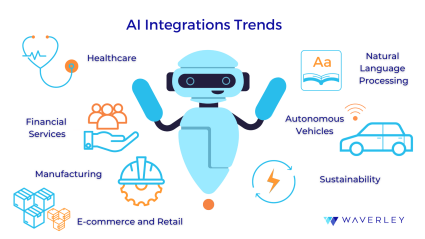
AI is now available outside of specialized IT firms, there are multiple AI-driven tools on the market that can help you automate certain tasks, generate text or images, etc. AI technology has become more popular across a range of industries, including manufacturing, retail, healthcare, and finance. Businesses are becoming more and more aware of how valuable AI is for automating processes, better decision-making, and improving consumer experiences.
- Healthcare: AI has been widely adopted in the healthcare sector, with applications in patient diagnostics, medication research, medical imaging, and customized treatment. Healthcare workers can now use AI-powered technologies to generate diagnoses and treatment recommendations that are more precise.
- Financial Services: AI is transforming the financial industry with applications in risk management, algorithmic trading, fraud detection, and customer care. In the financial industry, chatbots and robo-advisors are becoming more prevalent.
- Manufacturing: The use of AI, IoT, and automation in manufacturing is a hallmark of Industry 4.0. Production process optimization, downtime reduction, and overall efficiency are all benefits of AI-driven predictive maintenance and smart factories.
- E-commerce and retail: AI-driven personalization is changing the retail environment. Customer engagement is improved, and sales are boosted via recommendation engines, chatbots, and visual search tools.
- Natural Language Processing (NLP): For enhancing customer service and automating repetitive processes, NLP technologies such as virtual assistants or, for example, chatbots like Chatgpt, have become more and more popular across industries.
- Autonomous Vehicles: To ensure safer and more effective transportation, the automotive industry is aggressively investing in AI for autonomous vehicles and advanced driver assistance systems (ADAS).
- Sustainability: By maximizing energy usage, forecasting climate trends, and enhancing resource management, AI is being utilized to address environmental concerns.
Discover the steps to develop your IoT app. Read our article for expert insights.
AI Adoption statistic
To understand the boom of AI integrations in business, take a look at the following statistics:
- According to a study by Grand View Research, IncThe size of the global AI market was estimated to be US$136.55 billion in 2022 and will increase at a compound annual growth rate (CAGR) of 37.3% from 2023 to 2030. The paper explores how AI has impacted enterprises in terms of improved accessibility and expansion.
- According to a McKinsey study, 55% of the organizations polled have already deployed AI in at least one business function, while another 39% are currently piloting AI projects.
- The AI market, which MarketsandMarkets estimated at USD 150.2 billion in 2023, is projected to increase at a CAR of 36.8% between 2023 and 2030. It is anticipated that in 2030, revenues will total $1,345.2 billion. The historical data ranges from 2023 to 2030, with 2022 serving as the basic year for estimation.
- According to Fortune Business Insights, the global market for financial AI is predicted to expand at a CAGR of 21.6% between 2021 and 2030 (12 billion)
AI Potential and Relevance
The adoption of AI is not a passing trend; it is a fundamental change that will continue to influence how company landscapes develop in the future. Several factors support the continued significance of AI, including:
- Ongoing Improvements: Deep learning, reinforcement learning, and quantum computing advancements have accelerated the development of AI technologies. This continual development will produce AI systems that are even more accurate and effective.
- Cost Savings and Efficiency: AI helps businesses reduce costs, increase efficiency, and make data-driven decisions. Adopting AI will be essential for staying competitive as the global economy grows.
- More Effective Customer Experiences: Personalization and automation powered by AI increase customer pleasure, loyalty, and retention, giving firms a competitive edge.
- Data-Driven Insights: With the aid of AI, businesses can glean insightful facts from enormous databases, fostering creativity and rational decision-making.
- Focusing on Complex Challenges: AI is crucial in taking on difficult global problems including healthcare diagnosis, climate modeling, and urban planning.
Reasons for Implementing AI in Business Processes
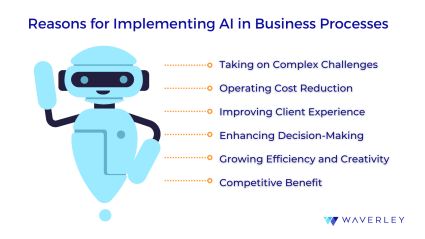
Artificial intelligence (AI) system integration in business can be driven by various motivations, with businesses trying to either solve existing issues, or increase business resilience and mitigate risk, or become more streamlined and competitive overall Here are some key motivations for adopting AI:
- Taking on Complex Challenges: AI is used to address complicated challenges that are difficult to handle otherwise using conventional methods. This can involve activities like picture identification, natural language understanding, and predictive analytics. Healthcare firms, for instance, use AI to identify diseases from X-rays and MRI pictures to help doctors identify illnesses more quickly and accurately.
- Operating Cost Reduction: AI can automate repetitive processes, boost operational efficiency, and lessen the need for manual labor, all of which can save operating costs. The customer service industry is a good example, as chatbots and virtual assistants handle routine inquiries, eliminating the need for human employees and cutting labor expenses.
- Improving Client Experience: By evaluating consumer information and preferences, AI may provide specialized recommendations and help. For instance, AI algorithms are used by e-commerce sites like Amazon to suggest goods to users based on their browsing and purchasing patterns.
- Enhancing Decision-Making: AI offers data-driven forecasts and insights that can help in decision-making. For instance, financial firms use AI to optimize investment plans through algorithmic trading, risk assessment, and fraud detection.
- Growing Efficiency and Creativity: AI tools can help workers with their tasks, increasing productivity as a whole. AI-powered simulation and optimization tools are used by businesses in design and production to speed up product development and cut down on design iterations.
- Competitive Benefit: Early adopters of AI gain a competitive edge by anticipating market trends and providing ground-breaking solutions. Companies that specialize in self-driving cars, like Tesla, for instance, employ AI to establish themselves as leaders in the field.
Now, let’s look at real-world examples of how AI has solved specific business problems for different companies:
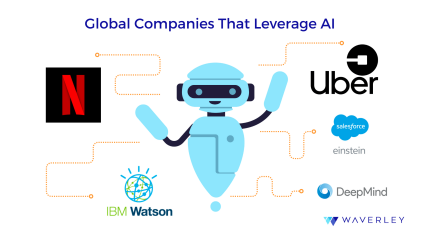
- Netflix: Netflix analyzes user viewing patterns and preferences using AI algorithms to suggest movies and TV series to customers based on their tastes. User engagement and retention have increased dramatically as a result of this personalization.
- IBM Watson: Watson, IBM’s AI platform, is used in the medical field to identify disorders. It has been effective in assisting oncologists in identifying treatment alternatives by reviewing a patient’s medical background and the most recent research findings.
- Uber: Uber uses AI to optimize routes, connect drivers and riders, and set demand-based pricing. By doing this, efficiency is increased and riders are guaranteed the quickest and most affordable rides.
- Salesforce Einstein: Salesforce’s CRM product, Einstein, also uses AI. It helps marketing and sales teams foresee client demand, automate processes, and provide more individualized customer experiences.
- DeepMind: Google’s DeepMind has made progress in applying AI to the medical field. In one famous instance, DeepMind’s AI was able to recognize diabetic retinopathy and other eye problems in medical photographs, facilitating early detection and treatment.
AI Integration Strategies
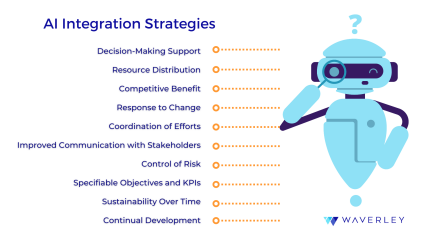
Every day companies trying to integrate AI face many challenges and to navigate these complexities, keep the costs in control and succeed in their endeavors, having a well-defined AI integration strategy tailored to their unique needs and goals is not just beneficial — it’s essential. Here’s how the creation of your custom AI integration strategy and sticking to it will help your business avoid the hurdles this process often presents.
- Decision-Making Support: A clear AI strategy gives an organization direction and a goal, acting as a compass. Every level of AI-related decision-making, from daily operations to long-term investments, is guided by it. Decisions made in the absence of a clear plan may be haphazard, inconsistent, and reactionary, which could result in inefficiencies and missed opportunities. A customized approach helps decisions stay on target and in line with the larger goal and vision.
- Resource Distribution: Because AI resources are often costly, being very careful and forward-thinking can save your budget in the long run. By giving priority to AI projects that most directly advance the goals of the business, a well-designed strategy aids in resource allocation optimization. This not only maximizes the value from AI utilization but also helps to avoid wasting time and resources on AI projects that do not bring immediate value.
- Competitive Benefit: AI certainly can help your business differentiate from the competition, but only if utilized wisely in the areas that need it most. An exercise that our Business Analysts often go through with customer to find the optimal areas for AI is a SWOT analysis to determine the company’s strengths, weaknesses, opportunities, and threats and create a competitive edge with AI. It ensures long-term viability by enabling the organization to carve out a niche and set itself apart from rivals.
- Response to Change: Organizations need to be adaptable if they want to succeed in a changing world of AI. A clearly defined approach is adaptive rather than stagnant. It enables a company to foresee and adapt to changes in the industry, technology, rules, and consumer preferences, while still keeping in mind your original goals and objectives for AI. An organization can stay ahead of the curve and continue to be relevant by routinely assessing and modifying the AI strategy to make use of the latest advancements.
- Coordination of Efforts: The departments and teams that make up large organizations each have their own roles and responsibilities and when it comes to adopting new tools and approaches, often take a while to adapt. If your changes are coordinated through a customized AI adoption plan, you’ll ensure that everyone is aware of all the reasons to use the new AI tools, the specifics and expected outcomes.
- Improved Communication with Stakeholders: Stakeholders, such as staff members, investors, clients, and business partners, want openness and direction. A clearly defined AI strategy offers a captivating story that can be effectively shared with these stakeholders. It fosters confidence and trust, which can be important for retaining customers, investors, and employees amidst your modernization efforts.
- Control of Risk: Risks are present in any business effort, but strategic planning enables firms to proactively identify, evaluate, and manage these risks. An organization can lessen the effects of unforeseen difficulties in AI integration and maintain stability by being aware of potential dangers and having backup plans in place.
- Specifiable objectives and key performance indicators for your AI strategy: SMART (specific, measurable, achievable, relevant, and time-bound) goals are part of a customized AI adoption approach. These objectives are necessary for monitoring development and tracking key achievements. Thus, organizations can measure progress objectively and make data-driven decisions by setting KPIs that are in line with the AI strategy.
- Sustainability Over Time: Although short-term profits may be alluring, they shouldn’t be at the expense of sustainability in the long run. Making hasty decisions that can jeopardize the organization’s long-term viability is avoided by having a clearly defined plan in place.
Selecting the Right AI Tools and Technologies
Organizations need to select the appropriate tools and technologies that are in line with their unique business requirements if they are to properly utilize AI’s potential. We will introduce numerous AI tools, frameworks, and technologies in this blog that are available for diverse business needs. We will also offer advice on how to use AI for your business, but first we’ll look at how to select the best tools based on criteria like scalability, compatibility, and necessary functionality.
What does your business need?
Understanding your unique business goals and objectives is essential before delving into the world of AI tools and technologies. Think about the following questions:
- What are the main issues or possibilities that AI can solve for my company?
- What are my long-term objectives for applying AI?
- Do I require AI for data analysis, automation, customer support, or other tasks?
After having carefully answered the previous questions, the selection process begins by considering the following:
Types of AI Tools and Technologies
AI includes an extensive range of instruments and innovations. Here are a few significant groups:
- Machine Learning Frameworks:
- Google’s TensorFlow, an open-source deep learning framework.
- Facebook’s open-source machine learning package, PyTorch.
- A flexible ML library for different algorithms called scikit-learn.
- Natural Language Processing (NLP) Tools:
- An open-source NLP text processing library called SpaCy.
- Popular natural language processing library known as NLTK.
- An NLP model that has been taught to recognize the context in text – BERT.
- Data Analytics and Business Intelligence Tools:
- Apache Spark is a potent tool for processing and analyzing large amounts of data.
- A tool for data visualization and insightful report writing like Tableau.
- Microsoft’s business analytics platform for data visualization called Power BI.
- AIaaS (AI as a Service):
- Rekognition, Polly, and Comprehend are just a few of Amazon’s AWS AI Services‘ offerings.
- Vision AI, Language AI, and AutoML are some of the AI features offered by Google Cloud AI.
- Microsoft’s AI services for a variety of uses under the umbrella ofd Azure AI.
- Customized Programming:
- If your demands are extremely specific, think about using Python, Java, or C++ for custom AI development Services. Waverley’s been helping companies implement their AI solutions from scratch offering the utmost flexibility and customization.
Let’s shape your future with AI integration. Contact us for a consultation.
Factors to Take into Account When Selecting AI Tools
Take a look at the following list and its specific questions as a guide for businesses to take into account for the selection AI tools process:
- Scalability: Can the tool grow with your company as your needs for AI do?
- Compatibility: Can the tool be used with your current systems and technologies without any problems?
- Effectiveness: Does it provide the features and capabilities needed for your particular use case?
- Costs: What is the overall cost of ownership, including registration, instruction, and upkeep?
- Assistance and Community: Does the tool have a vibrant user base and dependable customer service?
- Data Privacy and Security: Does the tool adhere to industry-specific data privacy laws?
PoC, Skill Development, and Adaptation
It’s wise to start with a Proof of Concept (PoC) when integrating AI in your company to assess the applicability and effectiveness of the selected AI tool or technology on a smaller scale. Once the tool is ready and configured for use, we recommend investing in training and skill-development programs for your employees to make sure they have the knowledge required to use AI products effectively. In order to be competitive and in line with your business goals in the ever-changing AI landscape, you should also periodically assess the performance of your chosen tools and be prepared to change to newer, better solutions as they become available.
12 Steps to Implement AI in Application
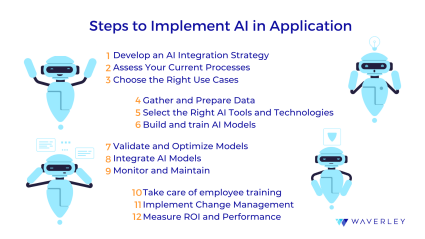
AI implementation is a strategic process that needs to be carefully planned and carried out. If you’re wondering how to integrate AI into your business successfully, we’ve outlined some basic steps that can help get you started faster.
- Develop an AI Integration Strategy
A clear strategy that is adapted to the demands and objectives of the company is crucial. It offers a clear road map, matches AI activities with corporate goals, and ensures resource effectiveness. - Assess Your Current Processes
A process evaluation can help highlight areas where AI can have a significant impact, such as automating routine operations or enhancing decision-making. - Choose the Right Use Cases
AI activities are guaranteed to contribute to the success of the organization if you carefully choose use cases that are in line with business objectives. Give top priority to cases that can benefit from data-driven insights, automate processes, or call for sophisticated identification of patterns. - Gather and Prepare Data
The basis of AI is high-quality data. Data collection, cleansing, and preparation guarantee that AI models have the knowledge they need to make reliable predictions or choices while abiding by data privacy laws. Waverley usually helps organizations with defining their data sources and coming up with ways to do the required data mining before proceeding with training the AI model. - Select the Right AI Tools and Technologies
The particular use case determines which AI tools and technologies, including ChatGPT integration services, are the optimal fit for your task. Considerations must be made for elements including scalability, simplicity of integration, and compatibility with current systems. - Build and Train AI Models
For AI models to effectively solve the specified challenge, architecture and algorithm design are essential. For model training, the appropriate data collection for machine learning methods are crucial. - Validate and Optimize Models
AI models perform effectively in realistic circumstances thanks to model validation and optimization. Model dependability is improved by adjusting the hyperparameters and dealing with problems like overfitting or underfitting. - Integrate AI Models
Realizing the benefits of AI models requires a smooth integration of these models into current systems and processes. The creation of APIs or connectors makes it easier for AI components and other software to communicate. - Monitor and Maintain
By putting in place a monitoring system, AI model performance can be tracked and kept efficient throughout time. In order to adjust to changing data patterns and business requirements, upgrades and retraining must be ongoing. - Take care of Employee Training
Successful deployment of AI technologies depends on educating employees about their advantages. Teams can use AI-driven insights and tools more successfully with the help of training. - Implement Change Management
The positive perception of AI business integration and fewer hurdles throughout the transition are fostered by addressing staff concerns and opposition through open communication. In addition, you should be sensitive to potential issues and adaptable enough if the developed solution needs to be modified to become a better fit for your business. - Measuring ROI and Performance
Understanding the ROI and performance of your AI efforts is crucial, just like with any other business endeavor. While ROI analysis measures the value of AI business integration, key performance indicators (KPIs) assist in evaluating the impact of AI on business outcomes.
How Much Does it Cost to Integrate AI?
Depending on a number of variables, including the complexity of the AI solution, the size of your organization, the amount of data you have, and the precise objectives you wish to achieve, the cost of integrating AI into business can vary significantly.
The price can vary from about $30,000 for a PoC to present to your stakeholders and validate the solution in your business environment, to a full-fledged solution costing you a few hundreds of thousands of dollars, but capable of saving you millions. Waverley’s AI architects are always ready to offer the optimal architectural solution for your needs and under your budget constraints, so if you have a vision in mind, please contact us using the form below to receive a more detailed estimate.
The following table shows some common problems businesses face when developing AI solutions and our tips on keeping the price to implement AI in your business within the required range:
| Problem | Challenges | Tips |
|---|---|---|
| Data Quality and Availability | As AI systems significantly rely on data, poor data quality or a lack of data availability might make it difficult and more expensive to integrate AI. | If you do not have the required data for training, our data mining experts can devise the optimal data gathering and enrichment strategies utilizing ready-made datasets, data generation and labeling tools, etc. |
| Change Management & Resistance | Change reluctance inside your company might hinder adoption of AI and raise costs. | Encourage an open and ongoing learning environment inside your company. Explore the advantages of AI with all parties involved and include them in the decision-making process. To assist staff in adjusting to AI-driven procedures, provide training and resources. |
| Complex Implementation Process | Integrating AI can be a difficult process that frequently requires numerous steps and iterations. | Begin by establishing a clear AI strategy and implementation roadmap. Divide the implementation process into more manageable chunks. Work together with knowledgeable AI providers or consultants to simplify the procedure and lessen its complexity. |
| Lack of AI Expertise | Skilled AI professionals are in high demand, making it costly to find and keep them. | Consider partnering with AI companies like Waverley, who already have a team of AI specialists worldwide, with equipped R&D labs you can tap into if needed. To obtain talent in AI, consider forming relationships with universities or research organizations. |
Summary
The potential of AI in modern business to transform operations simply cannot be emphasized. As we’ve shown in this post, using AI in your company processes opens up a wide range of opportunities, from increasing productivity and efficiency to gaining insightful information and enriching customer experiences.
The integration process must be approached, nevertheless, with careful planning and a well-defined strategy in mind. Even if the appeal of fast victories and short-term rewards may be alluring, sustained success requires a focus on the long-term advantages. It’s important to keep in mind that integrating AI into your organization requires continual dedication to maximizing its potential for development and innovation.
Finally, if you’re puzzled by how to incorporate AI into an app or any other kind of software – do not worry, with a bit of strategic planning, dedication, and a holistic approach as well as an experienced technology partner by your side, you can start receiving business value from AI in no time. Your organization may utilize AI to its fullest potential to promote growth, competitiveness, and success in the contemporary business environment by coordinating AI projects with your business goals, building an innovation culture, and resolving ethical problems.
Start your artificial intelligence integration today to secure a brighter future for your business.
FAQ
What is AI integration, and why is it important for businesses?
The term “AI integration” describes the integration of artificial intelligence technologies into various commercial activities and decision-making procedures. Because it may increase productivity, efficiency, and competitiveness, it is an essential step for modern enterprises. Artificial intelligence integration enables organizations to make data-driven decisions, enhance customer experiences, lower costs, and maintain a competitive edge in a market that is becoming more and more digital.
How do I determine which AI use cases are suitable for my business?
Start by identifying specific pain points or places where AI could fix problems or provide opportunities for your business before deciding on the appropriate AI use cases. Analyze your current procedures, the availability of data, and your strategic objectives in great detail. Prioritize use cases with a clear and reachable return on investment that are in line with your goals. Before tackling more sophisticated applications, think about beginning with smaller, manageable tasks to develop expertise and boost trust in AI technology.
How can AI be used to improve business?
AI has a variety of applications that can help businesses. It can automate routine tasks, which saves money and boosts productivity. Data analysis enabled by AI has the potential to reveal important insights that can improve decision-making. AI-driven suggestions and chatbots like GPT-4, for example, can improve the personalized consumer experiences. Supply chain management can be improved by predictive analytics, and cybersecurity can be improved by AI through real-time threat detection and mitigation. In the end, AI may assist companies in being inventive, competitive, and adaptable in a quickly changing commercial environment.
How can I start integrating AI into my business processes?
Follow these steps to begin using AI into your business processes: Determine your company’s goals and the specific issues that AI can help with first. Next, evaluate the infrastructure and quality of your data because AI depends so much on reliable data. Pick the appropriate AI tools or platforms based on your requirements and financial constraints. To determine the viability and impact of AI, start with a pilot project. If required, work with AI specialists or think about recruiting AI talent. In order to ensure alignment with your long-term business plan, tweak and scale up your AI activities as you gain more experience and observe positive results.
Transform your business processes with AI




